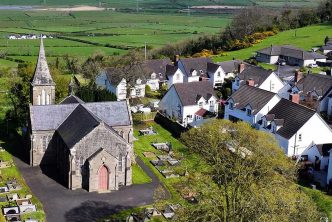Austria became the first EU member state to present an integrated network infrastructure plan – ÖNIP for short. This plan, which has been coordinated with the federal states and other stakeholders, specifies where infrastructure needs to be expanded and converted so that renewable electricity and renewable gases (methane and hydrogen) can be transported and made available. An analysis by Anja Herberth.

The Austrian abbreviations are truly unwieldy: ÖNIP, EAG, SUP, WAG, TAG – to name just a few. They represent the many small pieces of the puzzle that are necessary to implement the energy transition in a strategically sensible way. One of these parts was presented now: The ÖNIP, the Austrian Network Infrastructure Plan. We address the most important questions.
Why do we need an integrated network infrastructure plan?
The energy transition is a democratization of energy production: In the past, it was clear who was supplying – the system was managed with a great deal of certainty and the responsibilities were clearly distributed. With the Renewable Energy Expansion Act, anyone in Austria can now produce electricity privately and feed it into the grid. However, the old electricity grid is not designed for this task and has to be expanded.
According to experts, the energy transition is the biggest system transformation at European level since the Second World War. In recent years, critical voices have become louder and louder: It is far too poorly designed for a system reorganisation of this size – causing high costs, inefficiencies and more problems than necessary.
The costs for the necessary grid interventions are immense. EUR 141.6 million was spent on interventions to keep the grid stable in Austria alone in 2023. The term redispatch means the short-term use of power plants to avoid grid bottlenecks and keep the grid stable. Meaning: Let’s assume, for example, that there is a surplus of renewable energy in eastern Austria around midday – when the sun is shining and the wind is blowing. It cannot be transported to the west of Austria due to a lack of grid capacity. It is therefore possible that power plants will still have to be ramped up to cover the electricity demand in the west.
Currently, the effect of subsidies and investments for decentralized renewable energies is also fizzling out due to a lack of grid capacity. This means that there is a significant overproduction that cannot be sold or stored either domestically or abroad. Anyone currently interested in a PV system is increasingly receiving negative feedback from the energy supplier. For this reason, the credo of APG, Austrian Power Grid, has always been: If there is increased investment in the expansion of decentralized, renewable energy production, there must also be investment in the grid infrastructure. APG has budgeted investments of EUR 9 billion for these expansions up to 2034, which are now being revised again with the ÖNIP.
Decarbonization, i.e. the energy transition away from fossil fuels towards renewables, also means switching to and integrating renewable gases (especially biomethane and hydrogen). There are plans to rededicate around 1,400 km of existing gas pipelines for hydrogen transportation and to add around 300 km of new pipelines. In this context, Austrian Gas Grid Management Board member Bernhard Painz emphasized that the switch to hydrogen in companies is only possible when it is available. Biomethane plants are also connected to the gas grid. The conversion to a hydrogen supply network is expected to cost around EUR 2 billion. The first component in the hydrogen network is the H2Collector Ost, a gas pipeline from northern Burgenland towards Vienna and Schwechat. It is due to be completed in 2026 – a very optimistic and tight schedule.
These mammoth tasks not only require a joint strategy: These investments are very capital-intensive and must be planned and implemented with great care and a strategic approach.

What does “integrated” mean?
Electricity and gas complement each other in the energy mix. In order to ensure a stable and sustainable energy supply, all energy sectors and the entire value chain need to be considered together: From production to grids and storage to consumption. This is called sector coupling, because in the future it will be essential to build systems that are networked with each other and operate with maximum sustainability.
Based on the plan to be CO2-neutral by 2040, a model was developed in a consortium and the infrastructure requirements were derived from this.
What are the advantages of this joint infrastructure plan?
It provides a strategic framework that is coordinated with the stakeholders, including the federal states, and offers an improvement of the legal situation. In this way, the organisations expect to speed up the procedures under the law governing these investments. This is because the ÖNIP has already undergone a strategic environmental assessment and should therefore speed up the downstream approval procedures.
As described above, we should better integrate and utilize the available renewable energy in the market through implementation. The implementation of the ÖNIP should therefore reduce redispatch costs, i.e. the costs for grid stabilization and congestion management.
Our assessment: The energy transition is currently failing because of old structures – in the lines and networks, in the legal regulations and because end consumers are not sufficiently involved. The shortage of skilled workers is an additional factor here: There is already a shortage of 2,000 skilled workers among energy suppliers and 12,000 skilled workers in the industry – just in Austria. A shortage of well over 20,000 skilled workers is predicted by 2026.
This overall planning is an important set of rules for driving forward the energy transition. Up to now, the production of renewable energies has been promoted unilaterally – which has only intensified the challenges in the grids.
Such an intensive transformation of a system can only be achieved with holistic planning. Only time will tell whether the plan will hold or be sufficient – as was emphasized during the presentation, it will also be regularly fine-tuned. This is completely normal in projects of this dimension: No well-trodden paths are being trodden here, but new territory.
However, the time frame is more than ambitious. Elections will be held in Austria this year, and further resolutions on the EIWG and EABG are needed for the holistic implementation of the energy transition.
The Electricity Industry Act (EIWG) aims to eliminate ambiguities in the existing legal situation, close gaps and harmonize current practice and its legal framework. The Renewable Energy Expansion Acceleration Act (EABG), in turn, is intended to enable fast-track approvals for the expansion of the transmission grid. Infrastructure projects often take decades, with objections from local residents and NGOs prolonging the process. Without this acceleration, the above-mentioned goals cannot be achieved.






